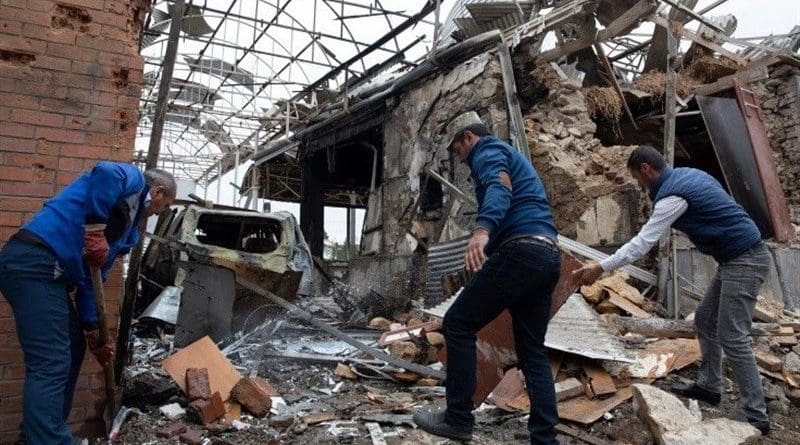Civilians Reported Killed As Conflict Between Armenia, Azerbaijan Spills Into Urban Areas
By RFE RL
(RFE/RL) — Deadly fighting between Azerbaijani and Armenian forces over the separatist Nagorno-Karabakh region has intensified as both sides blame each other for the collapse of a third attempt at a cease-fire.
Azerbaijan and Armenian reported civilian casualties in urban areas on October 28, two days after a U.S.-brokered cease-fire was to go into effect.
Azerbaijan’s Defense Ministry said 21 civilians were killed and 70 injured in Smerch multiple-rocket system attacks on the city of Barda, located in central Azerbaijan outside the Nagorno-Karabakh region. Four civilians were reportedly killed in another attack on the city on the previous day.
The Armenian Defense Ministry accused Azerbaijani forces of attacking civilian areas in Nagorno-Karabakh, including the shelling of a hospital and maternity clinic in the enclave’s main city, Stepanakert. The rocket attacks caused damage but inflicted no casualties. One civilian was killed and two others were injured in a rocket attack on the nearby town of Shushi (Susa).
Both sides denied the other’s claims that civilians were being targeted.
The International Committee of the Red Cross (ICRC) said urban areas had been hit and that one volunteer from the Azerbaijan Red Crescent Society was killed in the shelling. Two other volunteers were injured.
“Alongside thousands of civilians, the ICRC witnessed intense shelling in urban areas on both sides of the front line today, leading to death, destruction, injuries, and desolation,” it said in a statement.
“These latest exchanges signal that the Nagorno-Karabakh conflict risks spiraling out of control,” it warned.
Both sides have claimed the other is targeting civilians during a month of intense clashes that have drawn in world powers seeking to halt the worst fighting the region since a 1994 cease-fire.
U.S. Secretary of State Mike Pompeo on October 27 spoke separately by phone with Armenian Prime Minister Nikol Pashinian and Azerbaijani President Ilham Aliyev, urging both sides to pursue a diplomatic solution and abide by the cease-fire brokered by Washington over the weekend.
Two Russian-brokered humanitarian cease-fires have similarly collapsed within minutes of going into effect.
Ethnic tensions in the region between Christian Armenians and their mainly Muslim neighbors have flared in Nagorno-Karabakh for decades.
Nagorno-Karabakh is recognized as part of Azerbaijan, but the ethnic Armenians who make up most of the population reject Azerbaijani rule. They have been governing their own affairs, with support from Armenia, since Azerbaijan’s troops were pushed out of the breakaway region in a war in the early 1990s.
The latest fighting began September 27, escalating quickly to involve heavy artillery, rockets, and drones. At least 1,000 people have been killed in the fighting.
Nagorno-Karabakh officials say 1,068 of their troops and 39 civilians have been killed in the clashes, while 122 civilians have been wounded.
Azerbaijan does not disclose its military losses, but they say the fighting has killed 69 civilians and wounded 322.
Russian President Vladimir Putin said last week that Moscow believes the death toll from the fighting was nearing 5,000.
Aliyev said on October 28 that Armenian forces had lost 5,000 troops, a claim denied by the Armenian side.
“As to our losses, I’ve said we will make them public after the fighting is over. But I have to say that they are a lot less [than Armenia’s losses],” he said.
Aliyev has demand that Nagorno-Karabakh be returned to Azerbaijan, as well as seven surrounding districts controlled by Armenian forces.
Armenia says it will not withdraw from territory it views as part of its historic homeland and where the population needs protection.
Heavy fighting has been reported on multiple fronts in recent days, with Azerbaijani forces reportedly capturing territory in the southern sector along the border with Iran.
Iran’s Foreign Ministry said Deputy Foreign Minister Abbas Araqchi visited areas near Iran’s border with Azerbaijan and warned the warring parties against harming the security of Iranian territories.
“The security of border regions, dams, and constructions is highly significant for the Islamic Republic of Iran and is a red line,” Araqchi said, according to IFP News.
Araqchi plans to begin a trip on October 28 to several countries, including Armenia, Azerbaijan, Turkey, and Russia, to discuss the crisis, the Iranian Foreign Ministry said.
The United States, France, and Russia — co-chairs of the Minsk Group of the Organization for Security and Cooperation in Europe (OSCE) — said their foreign ministers would meet on October 29 in Geneva to discuss the Nagorno-Karabakh issue.
The Minsk Group, formed to mediate the conflict, said the meeting would “to discuss, reach agreement on, and begin implementation, in accordance with a timeline to be agreed upon, of all steps necessary to achieve a peaceful settlement of the Nagorno-Karabakh conflict.”
Ahead of that meeting, Russian President Vladimir Putin spoke by phone on October 27 with his Turkish counterpart, Recep Tayyip Erdogan, telling him about contacts with the leadership of Azerbaijan and Armenia and the “steps being taken to achieve a cease-fire as soon as possible and de-escalate the crisis,” a Kremlin statement said.
The conflict over Nagorno-Karabakh has sparked concerns over a wider conflict in the South Caucasus drawing in NATO member Turkey, which is an ally of Azerbaijan, and Russia, which has a military pact with Armenia.
Turkey has demanded a bigger role in the Minsk Group, which Ankara and Baku say has sidelined the Nagorno-Karabakh issue for decades without finding a lasting solution.

